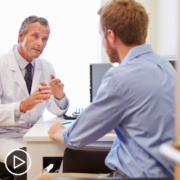Prostate Cancer Treatment Decisions: Which Path is Best for YOU?
Prostate Cancer Treatment Decisions: Which Path is Best for YOU? from Patient Empowerment Network on Vimeo.
Which prostate cancer treatment path is best for you? Dr. Alicia Morgans discusses how multiple factors, including disease progression and patient goals, determine which treatment path is best to help improve a patient’s outcome and overall quality of life.
Dr. Alicia Morgans is an Assistant Professor of Medicine at the Robert H. Lurie Comprehensive Cancer Center of Northwestern University.
See more from The Pro-Active Prostate Cancer Patient Toolkit
Related Resources

What Do Prostate Cancer Patients Need to Know About COVID-19? |

|

How Does Prostate Cancer Staging Affect Treatment Approaches? |
Transcript:
Dr. Alicia Morgans:
The main factors I think about when approaching a treatment plan for a patient is to understand is this treatment for cure. Are we able to cure this patient? Is that our goal? Or are we in a situation where we know that the cancer is going to be incurable, but we can prolong that individual’s life and improve the quality of life that he has?
That is a major breakdown or separation point in how we approach treatment. Once we figure that out, we can try to sort through among all the choices. If we’re going to use curative treatment to the prostate itself, what do we think is best for you as an individual man? And what do we think is possible from a medical perspective? Whether that’s radiation or surgery or even just watching and waiting with an active surveillance plan, there may be choices.
And similarly, with metastatic prostate cancer or advanced prostate cancer that’s incurable or not able to be cured, what are the medical treatments that we can use? And what are the choices that you as a man with prostate cancer want to make to really maximize your benefit – thinking through what’s important to you? What barriers do you have? And how do you want to go through your treatment sequence?
We’re actually really fortunate in prostate cancer care to have many choices, whether it’s in treating localized curable prostate cancer or in treating metastatic prostate cancer that we’re really trying to treat to prolong life and improve quality of life. In each setting, in most cases, there are multiple choices to make along the journey. Sometimes these choices would exclude other choices in the future, but sometimes they don’t. Sometimes you can choose A or B, because in a few months, you’re going to have the opposite option available to you. So, exactly what your choices are going to be are going to be important for you to speak with your doctor about.
But having those choices really empowers men to get engaged in each of these treatment decisions to explain this is my preference for that side effect or this particular toxicity, and I’m going to choose this treatment, because it works best for me because I can get to work or because it doesn’t lead to incontinence or because it doesn’t cause me to lose my hair or whatever the reason is. Men’s preferences can be so importantly incorporated into the treatment decision, because we have all the choices we have in treating prostate cancer.










